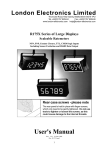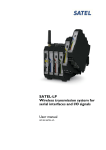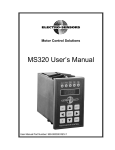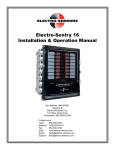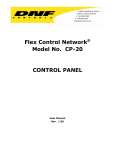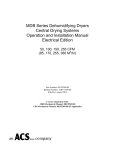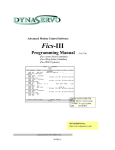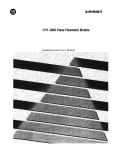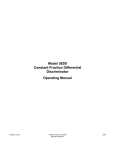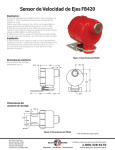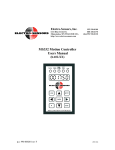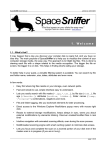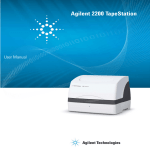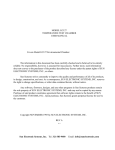Download TR400SGA User Manual
Transcript
PM500 User’s Manual Part Number: 990-005700 Rev A Electro-Sensors, Inc. 6111 BLUE CIRCLE DRIVE MINNETONKA, MN 55343–9108 www.electro-sensors.com [email protected] [email protected] Local: Toll-Free: Fax: 952.930.0100 800.328.6170 952.930.0130 Copyright © 2014 Electro-Sensors, Inc. All rights reserved. No part of this document can be duplicated or distributed without the express written permission of Electro-Sensors, Inc. While the information in this manual has been carefully reviewed for accuracy, Electro-Sensors, Inc. assumes no liability for any errors or omissions in the information. Electro-Sensors, Inc. reserves the right to make changes without further notice to any part of this manual or to any product described in this manual. ii Table of Contents Table of Contents ........................................................................................................................................................ iii List of Figures ............................................................................................................................................................. iv List of Tables .............................................................................................................................................................. iv Introduction to this Manual .............................................................................................................................................. v Introduction to this Product ............................................................................................................................................ vi The User Interface ........................................................................................................................................................... 1 The User Interface Tables ................................................................................................................................................ 2 (DIAG Menu) How to Perform the Diagnostic Functions ........................................................................................... 2 (SECR Menu) How to Change the Security Settings ................................................................................................... 2 (VAR Menu) How to Change a User Variable ............................................................................................................ 2 Diagnostics................................................................................................................................................................... 3 (SECR Menu) The Security Variables ............................................................................................................................. 4 User Variable Descriptions and Formats ......................................................................................................................... 5 (Var01 to Var04) Relay Output Setpoints .................................................................................................................... 5 (Var07) Relay ADC Select .......................................................................................................................................... 5 (Var08) Relay Output Function ................................................................................................................................... 5 (Var 09) Switch Input Function ................................................................................................................................... 6 (Var 10 & Var 12) Analog Input A& B User Units at Lower Calibration Point .......................................................... 6 (Var 11 & Var 13) Analog Input A & B User Units at Upper Calibration Point ......................................................... 6 (Var 14) ADC Averaging ............................................................................................................................................. 6 (Var 15) Analog Input Enable ...................................................................................................................................... 6 (Var 16) Factory Calibration Selection ........................................................................................................................ 6 (Var 17) Display Function Select ................................................................................................................................. 7 (Var 20 & 22) Analog Output Minimum Rate in User Units ....................................................................................... 8 (Var 21 & 23) Analog Output Maximum Rate in User Units ...................................................................................... 8 Var 24) Analog Selection ............................................................................................................................................. 8 (Var 25) Analog Output Response ............................................................................................................................... 8 (Var 30) Modbus Node Address .................................................................................................................................. 8 (Var 31) Modbus Baud Rate ........................................................................................................................................ 8 (Var 32) Modbus Parity ............................................................................................................................................... 8 (Var 33) Modbus Data Type ........................................................................................................................................ 8 Programming the Analog Inputs ...................................................................................................................................... 9 Programming the Relay Outputs ...................................................................................................................................... 9 Programming the Analog Outputs ................................................................................................................................... 9 The LRC Non-volatile Memory Check Feature ............................................................................................................... 9 (DIAG Menu) The Diagnostic Functions ...................................................................................................................... 10 (Anou) How to Check the Analog Output ................................................................................................................. 10 (SIn) How to Check the Switched Inputs ................................................................................................................... 10 (rELY) How to Test the Relay Outputs ..................................................................................................................... 10 (HEyP) How to Verify that the Keypad is Working .................................................................................................. 10 (UEr) How to Find out the Firmware Version Number ............................................................................................. 10 (rESE) How to Reset the User Variables to their Factory Default Values ................................................................. 10 (OFFS)How to Calibrate the Analog Input Offset ..................................................................................................... 11 (SCAL) How to Calibrate the Analog Input Scale ..................................................................................................... 11 Application Examples .................................................................................................................................................... 12 Appendix A—Panel Cutout Dimensions ....................................................................................................................... 13 Wiring Practices for Industrial Equipment .................................................................................................................... 14 Appendix B—Wiring the PM500 .................................................................................................................................. 15 AC Input Power Supply (TB1-1, TB1-2) ................................................................................................................... 15 485 communications (TB1-4 to TB1-6)..................................................................................................................... 15 Switch inputs (T1-7 to TB1-9) ................................................................................................................................... 15 4/20 mA Analog Input (TB2-10- TB2-15)................................................................................................................. 15 4/20 mA Analog Output (TB1-16 to TB1-18) ........................................................................................................... 15 Relay Outputs (TB3-1 to TB3-18) ............................................................................................................................. 15 Wiring Diagrams ........................................................................................................................................................ 16 Wiring Diagrams continued. ...................................................................................................................................... 17 iii Appendix C—PM500 Specifications ............................................................................................................................. 18 Variable Logs ................................................................................................................................................................. 19 User Variables Log .................................................................................................................................................... 19 Communication Variables Log .................................................................................................................................. 20 Calibration Variables Log .......................................................................................................................................... 20 Security Variable Log ................................................................................................................................................ 20 Index .............................................................................................................................................................................. 21 PM500 User’s Manual Back Cover................................................................................................................................ 26 List of Figures Figure 1; PM500 Wiring Diagram ................................................................................................................................. 16 Figure 2; 2 Relay outputs wiring diagram ...................................................................................................................... 17 Figure 3; 6 Relay outputs wiring diagram ...................................................................................................................... 17 List of Tables Table 1; Associations Between Keys, LEDs, and Menus ................................................................................................ 1 Table 4; How to perform diagnostic functions ................................................................................................................. 3 Table 5; Security Variable “SdEF”, Security Definition .................................................................................................. 4 Table 6; Var07, ADC select Variable .............................................................................................................................. 5 Table 7; Var08, Relay Output Function Codes ................................................................................................................ 5 Table 8; Var17, Display Function Codes ......................................................................................................................... 7 Table 9; Var17, Display Function Code 4, Relay Output Status ...................................................................................... 7 Table 10; User Variable Log .......................................................................................................................................... 19 Table 11; Communications Variables Log ..................................................................................................................... 20 Table 12; Calibration Variables Log .............................................................................................................................. 20 Table 13; Security Variables Log ................................................................................................................................... 20 iv Introduction to this Manual What is in this manual? This installation and operation manual provides detailed technical information about the PM500 Programmable Process Ratemeter. It should serve as your technical resource to install, set up, operate, and test the PM500. Who should use this manual (audience) Keep in mind that the function of the PM500 installed in a mechanical process is to monitor position, capacity, speed, etc; therefore, it must be installed by qualified personnel only. This manual is designed for persons who have the primary responsibility to install, set up, operate, and test the PM500. The secondary audience would be those persons seeking technical information about the electrical concepts and operation of the PM500. Knowledge level Persons installing, setting up, and operating the PM500 should have good knowledge and understanding of electrical and mechanical concepts and principles pertaining to Programmable Process Ratemeters. Again, the PM500 should be installed by qualified personnel only. Notices Installing Electro-Sensors, Inc., products is the responsibility of the purchaser, and is in no way guaranteed by Electro-Sensors, Inc. While the information in this manual has been carefully reviewed, Electro-Sensors, Inc., assumes no liability for any errors or omissions in this manual. Additionally, ElectroSensors, Inc., reserves the right to make changes to any part of the information in this manual or the product described herein without further notices. No part of this manual may be photocopied, reproduced, or translated to another language without the prior written consent of Electro-Sensors, Inc. v Introduction to this Product The PM500 is a stand-alone display device that accepts up to two 4–20 mA DC analog input signals. The display has four 7-segment LED digits with decimal points. The PM500 can be programmed to display any value of user units from ’00.00’ to ‘9999’ and from ‘-0.00 to 999’. The PM500 has either two SPDT relay outputs or four SPDT with programmable functions (UNUSED, UNDER and OVER). The PM500 has an option for 2 16 bit 4 to 20 mA output signals, which are isolated from the 4 to 20 mA input signals. The PM500 display has 5 status LED’s so you can determine which input you are viewing, as well as for indicating when the PM500 is in the programming, or diagnostics modes. It also signals the user when there is a sensor failure. The PM500 has 2 regulated +24 VDC outputs that can each supply 50 mA maximum. (This supply can be used to power sensors, etc.). vi The User Interface The user interface consists of a keypad, the four character display, five discrete LEDs, several user variables, and three menus—the user variable menu, the security menu, and the diagnostic menu. The three menus are each accessed by a menu key; the VAR key accesses the user variable menu, the DECIMAL POINT key accesses the security menu, and the DIAG key accesses the diagnostic menu. In each of these menus there is an intermediate level (level 2) enabling you to select a menu item and a final level (level 3) enabling you to change or edit the selected menu item. The method for selecting which menu item to edit depends on what menu you are in. In the VAR menu use the up, down, left, and right arrow keys to edit the two digits of the user variable number. In the security menu and in the DIAG menu use the up and down arrow keys to scroll through menu item prompts. Once a menu item has been chosen, press the ENTER key to move to the final level (level 3) to edit the variable value or perform the diagnostic action. To edit a user variable value, use the left and right arrow keys to move the cursor (the flashing digit) to the digit whose value you want to change, then use the up and down arrow keys to change the value of the digit. Press the ENTER key to accept the value or press the ‘abort’ key to throw away the changes that you have made. (The ‘abort’ key depends on which menu you are in, i.e. the VAR key enters the user variable menu and the VAR key aborts the user variable menu.) For example, to change a user variable value, press the VAR key to go to level 2—select user variable number. While in level 2, edit the display so that it shows the user variable number whose value that you want to change. Then, press the ENTER key to accept the user variable number and go to level 3—change user variable value. While in level 3, edit the display so that it shows the new user variable value. Then, press the ENTER key to accept that value and return to level 1—the user units display level. When the user accepts a value the PM500 will test it and will not allow an out-of-range or illegal value. If at any time you don’t like the changes that you have made while you are in a particular level, press the abort key to discard the changes and go back to level 1—the user units display level. The SECR menu works in a similar way to allow you to change the security variable values. The diagnostic menu will allow you to perform a diagnostic test, to perform calibration actions, or to observe the state of the system, thereby enabling you to set up your system or to troubleshoot your system installation. The five front panel LEDs are used to indicate which menu you are in or to indicate status information about the PM500. There are five LEDs: Sensor Error, PROG, INPUT A, INPUT B, and KEY ERR. When a menu key is pressed the LED associated with that menu turns on to indicate which menu you are in. Key LED Decimal Point key VAR key DIAG key PROG LED on & Disp reads “ SEC” PROG LED & Disp reads “Prxx” PROG LED & disp reads “dIAG” Menu Change Security Variable Change User Variable Perform Diagnostic Action Table 1; Associations Between Keys, LEDs, and Menus The Input “A” LED is associated with input channel A. The Input “B” LED is associated with input channel B. The Input LED that is illuminated shows the user which input channel is being displayed.l The KEY ERR LED is used to indicate an invalid key press, an invalid user variable number, or an invalid user variable value. It shuts off after a timeout period of 500 ms. The PROG LED is ‘OFF’ when the display is showing a real-time value selected by the display function variable. 1 The User Interface Tables (DIAG Menu) How to Perform the Diagnostic Functions 1. 2. 3. Press the DIAG key Use the arrow keys to select desired variable and press ENTER a. When finished hit DIAG key to exit menu Press DIAG key one more time to exit the DIAG Menu Note: See table on next page for Diagnostics description (SECR Menu) How to Change the Security Settings 1. 2. 3. Select the Security menu by pressing the Decimal Point Key. Use up and down arrows to select the desired variable a. Press Enter b. Change variable and accept by pressing Enter Key or aborting change by hitting Decimal Point Key Press Decimal Point Key to exit Security Menu (VAR Menu) How to Change a User Variable 1. 2. 3. Press the VAR key Use the Arrow Keys to navigate to desired parameter a. Press enter key to select or abort by hitting Var Key b. Change variable using arrow keys and press ENTER key to accept or Var Key to abort Press Var Key to exit Variable Menu. Note: Access to the VAR menu is still permitted during an LRC error in the PM500’s non-volatile memory 2 Diagnostics Diagnostic Display Value Function You have Entered Diagnostic Mode dIAG dIAG Diagnostics Output percent “0XXX”. Verify your analog out by scrolling from 0 to 100% 0 = 4 mA 100 = 20mA Anou Analog Output Read current Switch state SIn Switch Input Read current switch state rELY Relay states. “XXXX” Relay one–1’s. Relay two–10’s. Relay one–100’s. Relay two–1000’s. Relay Test “0000” (When relays are off, 1 value denotes on) HeyP Keypad Test VAR key–“1111.”. Up arrow key–“222.2”. REV key–“33.33”. Left arrow key–“4.444”. ENTER key–“5555.”. Right arrow key–“666.6”. Decimal point key–“77.77”. Down arrow key–“8.888”. Tests individual buttons on keypad UEr Firmware Version “XX.XX” Displays Firmware Version “dOnE” rESE Reset Unit Resets Unit to Factory Defaults OFFS ADC Offset Calibration ADC value in hexadecimal of the actively displayed ADC input. SPAN ADC Span Calibration ADC value in hexadecimal of the actively displayed ADC input. Table 2; How to perform diagnostic functions 3 (SECR Menu) The Security Variables The SECURITY menu is accessed by pressing the DECIMAL POINT key. In the security menu the user has access to three variables. The input password variable (PIn), the password definition variable (PdEF), and the security definition variable (SdEF). The security features defined by the security definition variable ‘SdEF’ are enabled anytime the input password ‘PIn’ is different from the password definition ‘PdEF’. In other words, in order to access locked-out functions the user has to enter an input password that matches the password definition (PIn = PdEF). In order to lock out unauthorized changes to user variables the user must enter a password definition that is unknown to unauthorized users (PIn ≠ PdEF). Any attempt to access the password definition by an unauthorized user will result in a display of “HIdn” (hidden). The following table indicates how menu access is controlled by the digits of the security definition variable. Display Digits Digit Function Function Codes VAR Menu Digit 1 When this menu is locked the user variables can be viewed but not changed. DIAG Menu Digit 2 When this menu is locked, access to the diagnostic functions are denied. Digit 3 Digit 4 0–Menu Unlocked 1–Menu Locked Not used Not used Table 3; Security Variable “SdEF”, Security Definition 4 User Variable Descriptions and Formats (Var01 to Var04) Relay Output Setpoints User Variable 01— Variable 04 These variables contains the trip point levels for relays. It is a value entered as user units. They can have decimal places and be positive or negative. (Var07) Relay ADC Select User Variable 07—Relay ADC select. Var07 allows the user to select the ADC input that is assigned to the given relay output. The user can choose from three function codes (one is unused). The following table gives the relay output function codes and shows which Var07 digit corresponds to which relay output. Display Digits Digit 1 Digit 2 Digit 3 Digit 4 Digit Function Function Codes Relay Output 1 Relay Output 2 Relay Output 3 0–Unused 1–Analog input A 2–Analog input B Relay Output 4 Table 4; Var07, ADC select Variable (Var08) Relay Output Function Allows the user to select the relay output function(s). The user can choose from three function codes (one is unused). The following table gives the relay output function codes and shows which Var08 digit corresponds to an individual relay output. Display Digits Digit 1 Digit 2 Digit 3 Digit 4 Digit Function Function Codes Relay Output 1 Relay Output 2 Relay Output 3 0–Unused 1–Under setpoint 2–Over setpoint Relay Output 4 Table 5; Var08, Relay Output Function Codes The unused function keeps the respective relay permanently dropped-out. The Under setpoint function pulls-in the relay when the 4/20 mA input signal rises to the trip point level, and dropsout the relay when the 4/20 mA input signal falls below the trip point level by 2%. The Over setpoint function pulls-in the relay when the 4/20 mA input signal falls to the trip point level, and drops-out the relay when the 4/20 mA input signal rises above the trip-point level by 2%. Note: The relay hysteresis is fixed at 2% of the “Maximum Rate in User Units” value. 5 (Var 09) Switch Input Function This is not implemented at this time (Var 10 & Var 12) Analog Input A& B User Units at Lower Calibration Point User Variable 10—Analog Input A User Units at lower calibration point (typically at 4 mA input). User Variable 12—Analog Input B User Units at lower calibration point (typically at 4 mA input). This variable (a.k.a. “Minimum Rate in User Units”) is used to scale a 4 mA signal into a displayed maximum value in user units. The value entered into Var 10 & 12 is the number of user defined units (position, capacity, speed, etc,) processed by the system when the analog input signal is at its lowest calibration point. The lowest calibration point is usually at 4 mA, but that is not a requirement. Notes: 1. When used with TT420’s this value would typically be -40. 2. When used with ST420’s this would be the min value in RPM’s the ST420 was programed for. 3. When used as a percentage meter the value in Var 10 and Var 12 should be 0. (Var 11 & Var 13) Analog Input A & B User Units at Upper Calibration Point User Variable 11—Analog Input A User Units at upper calibration point (typically at 20 mA input). User Variable 13—Analog Input B User Units at upper calibration point (typically at 20 mA input). This variable (a.k.a. “Maximum Rate in User Units”) is used to scale a 20 mA signal into a displayed maximum value in user units. The values entered into Var 11& 13 is the number of user defined units (position, capacity, speed, etc,) processed by the system when the analog input signal is at its upper calibration point. The upper calibration point is usually set to 20mA, but that is not a requirement. Notes: 1. When used with TT420’s this value would typically be 248. 2. When used with ST420’s this would be the max value in RPM’s the ST420 was programmed for. 3. When used as percentage meter the value in Variable 11 and 13 should be 100. (Var 14) ADC Averaging Is not implemented at this time. (Var 15) Analog Input Enable Analog enable is used to enable or disable inputs individually. The outputs can be disabled to prevent a sensor error signal when only one sensor is being monitored. Var 15 selections are: “0000” disables both inputs. “0001” enables input ‘A’. “0010” enables input ‘B’ “0011” enables both the ‘A’ & ‘B’ inputs. The default is “0001”. (Var 16) Factory Calibration Selection When factory calibration select is set to ”0001”, it makes the ADC inputs use factory calibrated ADC values, not the default/user calibration value. These value are not cleared when resetting the unit. They can however be set using the 485 communications. When cleared variable 16 is resets to “0000” and the unit uses the default values/user set values. 6 (Var 17) Display Function Select Controls which real-time value is displayed by the user interface. The default function code is 0 (display in User Units). The following table gives the display function codes and a description of their meanings. Iif both inputs are enabled pressing the rate key will toggle between the inputs. So pressing the rate key will toggle the rate code between 0 and 1. It also will allow toggling between rate code 2 and 3. Function Code Function Description 2 3 ADC A Process position, capacity, speed, etc. ADC B Process position, capacity, speed, etc. ADC A current value ADC B current value 4 Relay Status 5 6 7 Analog A output DAC value Analog B output DAC value Switch Inputs 0 1 Display Units Modbus Address User Units1 30xx0 User Units2 30xx0 ADC 1 Bits, 0 to FFFF ADC 2 Bits, 0 to FFFF Boolean State (0 or 1) see Table 9 for more detail 0-4095 0-4095 00XX 30xx0 30xx0 30xx0 30xx0 30xx0 30xx0 Table 6; Var17, Display Function Codes Display Digits Digit 1 Digit 2 Digit 3 Digit 4 Digit Function Relay Output 1 Status Code 0–Dropped Out 1–Pulled In Relay Output 2 Relay Output 3 Relay Output 4 Table 7; Var17, Display Function Code 4, Relay Output Status 1 2 Var01 “Maximum Rate in User Units” scales the 4/20 mA analog input signal into user units for display function 0. Var01 “Maximum Rate in User Units” scales the 4/20 mA analog input signal into user units for display function 0. (Var 20 & 22) Analog Output Minimum Rate in User Units Analog Output Minimum Rate in User Units: (4 mA output setpoint). Var20 is used to set the point where the PM500 will output 4 mA on channel “A” when the display is at this value. Var22 is used to set the point where the PM500 will output 4 mA on channel “B” when the display is at this value (Var 21 & 23) Analog Output Maximum Rate in User Units Analog Output Maximum Rate in User Units: (20 mA output setpoint). Var21 is used to set the point where the PM500 will output 20 mA on channel “A” when the display is at this value. Var23 is used to set the point where the PM500 will output 20 mA on channel “B” when the display is at this value Var 24) Analog Selection When analog selection is set to (0001), it makes the analog output user units track the analog input user units. You will not set variables 20-23, as they are ignored. When variable 24 is cleared (0000) 20-23 again has authority over analog outputs. (Var 25) Analog Output Response Sets the analog output response time. This is the time it takes to change from 10-90% out. Time is listed below in seconds. This can be used to smooth the output or to filter out slight deviations. 1 = 0.00 7 = 1.3 2 = 0.020 8 = 2.5 3 = 0.040 9 = 4.8 4 = 0.080 10 = 9.5 5 = 1.7 11 = 20.0 6 = 0.57 (Var 30) Modbus Node Address Modbus Node Address sets the address for Modbus communications values 1 to 247 are valid.. (Var 31) Modbus Baud Rate Modbus baud rate sets the baud rate for Modbus communications values 0-4 are valid. 0 - 1200 BAUD 1 - 2400 BAUD 2 - 4800 BAUD 3 - 9600 BAUD 4 - 19200 BAUD (Var 32) Modbus Parity Modbus Parity: sets the parity for Modbus communications values 0-2 are valid. 0 - No Parity (default) 1 - Odd Parity 2 - Even Parity (Var 33) Modbus Data Type Modbus data type: the slave must use the same data type as the master. Different slaves can use different data types, as long as the data type of the slave’s response is the same as the data type of the master’s query. Values 0 to 5 are valid. 0 - Float High Low 32 bit Transmit Most Significant word First 1 - Float Low High 32 bit Transmit Most Significant word Last 2 - Long High Low 32 bit Transmit Most Significant word First 3 - Long Low High 32 bit Transmit Most Significant word Last 4 - Signed Integer (default) 16 bit 5 - Unsigned Integer 16 bit 8 Programming the Analog Inputs The ways to get the display and analog output you desire from the PM500 are presented below: 1. 2. 3. Input is calibrated. (default is typically accurate enough for temp probes, otherwise you will need to go to diagnostics and perform the offset and scale calibrations) Verify Input is properly programmed. a. If channel A is used: Variables 10 & 11 must be programmed (lower and upper setpoints). b. If channel B is used: Variables 12 & 13 must be programmed (lower and upper setpoints). c. Variable 15 must be set appropriately for your input configuration. Verify output is programmed. Programming the Relay Outputs In order for the relays to operate you must do the following: 1. Enter the setpoints for the relays by setting the variables 1 through 4. 2. Set the relays to trigger on the right input by using variable 7. 3. Turn on the relay to over or under setpoint tripping.in variable 8. Programming the Analog Outputs There are several aspects to getting the display and analog output you desire from the PM500. They are as follows: 1. Calibrate inputs. (Default is typically accurate enough for temp probes, otherwise you will need to go to diagnostics and preform the offset and scale calibrations) 2. Verify input is properly programmed. 3. Verify Program output is properly programmed. a. If channel A is used: Variables 21 & 22 must be programmed (lower and upper setpoints). b. If channel B is used: Variables 23 & 24 must be programmed (lower and upper setpoints). c. If you want to use the input setpoints to also be the output setpoints, set variable 24 (analog selection) to 0001. This is an easy way to make sure any changes to the inputs will always be reflected in the outputs (mirror), otherwise leave variable 24 to 0000 and set your outputs independent of the inputs. The LRC Non-volatile Memory Check Feature The LRC feature is a self-check the PM500 performs on its non-volatile memory upon power-up. User variables are stored in the non-volatile memory. If upon a power-up, the new LRC sum matches the previous LRC sum from the non-volatile memory, then the LRC self-check passes. But, if the new LRC sum does not match the previous LRC sum, then the LRC self-check flags an error. An LRC error means the values of at least one variable have been corrupted in the non-volatile memory (i.e., they don’t contain all the user’s previous values). During an LRC error the PM500 goes into a ‘fail-safe’ mode. It does not show the real-time display, but rather shows the message “LrC”. Also for an LRC error the relay outputs drop-out and the 4-20 mA analog output holds at 4.00 mA due to the corruption of the user variables. To prevent the PM500 from performing abnormally, the PM500 essentially stops performing (because any inadvertent change to the user variables may have changed its performance). The user then obviously knows something is wrong with the PM500’s user variables. Note: It is important the user fills in their application’s values in the ‘User Variable Log’ near the back of this PM500 User Manual. Because if an LRC error does occur, then there will be a correct list of variable values to compare to, when attempting to fix a corrupted variable situation. During a LRC error: Access to the Diagnostic Menu is allowed. Access and changes to the Security Menu are allowed (having no effect on the LRC error). Access to the Var Menu is allowed for read only. Changes to the Var Menu are not allowed. The unit can be reset to factory defaults. 485 communications will continue to work. 9 (DIAG Menu) The Diagnostic Functions The DIAGNOSTIC menu is accessed by pressing the DIAG key. Once inside the Diagnostics Menu, press the UP and DOWN arrow keys to scroll through the list of diagnostic functions. Each of the diagnostic functions is explained below. (Anou) How to Check the Analog Output At this time the 4-20 mA outputs are a fixed calibration. This diagnostic allows you to force the outputs to a given % out. This can be useful for trouble shooting.. (SIn) How to Check the Switched Inputs Select “ SIn” from the diagnostics menu. The display will show the status of the switch inputs. - The right most digit represents the first switch input (000X). - The digit that is the second most right represents the second switch input (00X0). - The DIAG key exits the “SIn” switch input test. (rELY) How to Test the Relay Outputs Select “ rELY” from the diagnostics menu. The display will show the status of the relay outputs. - The right arrow key pulls-in relay output 1 & 3, and sets the corresponding digit of the display to a 1. - The left arrow key pulls-in relay output 2 & 4, sets the corresponding digit of the display to a 1. - The ENTER key drops-out all relays, clears the corresponding digits of the display to 0. - The DIAG key exits the “rELY” Relay Output test. (HEyP) How to Verify that the Keypad is Working Select “HEyP” from the diagnostics menu. Each key corresponds to a unique display. Press each key to test its response. The DIAG key exits the test. (UEr) How to Find out the Firmware Version Number Select “ Uer” from the diagnostics menu. The firmware version and revision are displayed in “XX.XX” format. The two digits before the decimal point reflect the version number. The two digits after the decimal point reflect the revision number. The DIAG key exits the test. (rESE) How to Reset the User Variables to their Factory Default Values 1. 2. Select “rESE” from the diagnostics menu. Then press the ENTER key. This does not reset the processor, it only resets the user variables Var01 through Var08 in both the RAM memory and the nonvolatile FRAM memory. When the display shows “done”, press the DIAG key to exit. Or, hold down the DIAG key on power-up. When the display shows “rESE” then release the DIAG key. This does everything the “rESE” diagnostic does, but also resets the processor. Note: After doing a “reset-to-factory-defaults”, the analog inputs may need recalibration. 10 (OFFS)How to Calibrate the Analog Input Offset This procedure calibrates the analog input (via calibrating the A/D converter’s low end-point). - The 4 mA low-end is initially factory calibrated via defaults, which for temperature probes should be more than adequate. When necessary follow the steps below. Calibrating the 4/20 mA analog input. 1. Set the display to read the input you want to calibrate. The diagnostic will calibrate whichever input is active. The front panel LED’s will tell you which input is active for calibration. 2. Press the ‘Diag’ key. 3. Scroll to ‘OFFS’. 4. Set your sensor to its minimum value. 5. Press the enter key and the display will start reading the ADC. It will display it in Hexadecimal. The 1’s digit will vary +/- 1 or 2 ADC bits. If it varies more wait until the sensor has settled. 6. Press enter to save the value or diag to back out without updating the ADC input. 7. Calibration is done for that channel now you should verify that variable 10 and 12 reflect the point you calibrated. This step can be done after calibrating both channels upper and lower ADC points. 8. You are done. (SCAL) How to Calibrate the Analog Input Scale This procedure calibrates the analog input (via calibrating the A/D converter’s high end-point). - The 20 mA high end calibration is initially factory calibrated via defaults, This should be more than adequate for temperature probes. When necessary recalibration of the analog input is possible, to do so follow the instructions below. Calibrating the 4/20 mA analog input. 1. Set the display to read the input you want to calibrate. The diagnostic will calibrate whichever input is active. The front panel LED’s will tell you which input is active for calibration. 2. Press the ‘Diag’ key. 3. Scroll to ‘SCAL’ and press enter. 4. Set your sensor to its Maximum value (20mA point) or a known operating value. 5. Press the enter key and the display will start reading the ADC. It will display it in Hexadecimal. The 1’s digit will vary +/- 1 or 2 ADC bits. If it is varying more wait until the sensor has settled. 6. Press enter to save the value or diag to back out without updating the ADC input. 7. Calibration is done for that channel now you should verify that Variable 11 and 13 reflects the point you calibrated. 8. You are done. 11 Application Examples A plant engineer is using an Electro-Sensors, Inc. SG1000x SlideGate Monitor to sense the position of a slide gate controlling the amount of grain flowing out of a hopper storage bin. The Electro-Sensors’ SG1000x SlideGate Monitor is programmed to output a 4 mA DC signal when the gate is in the fully-closed position, and output a 20 mA DC signal when the gate is in the fully-open position. Any gate position between the fully-closed and fully-open positions, will be represented by the SG1000x output signal being proportionally between 4 mA and 20 mA. Typically in such an application, the fully-closed slide gate position is referred to as being “0% open”. Likewise, the fully-open slide gate position is referred to as being “100% open”. In this example, an Electro-Sensors’ PM500 can be used to read the 4/20 mA signal coming from the SG1000x. The PM500 can be programmed to display the slide gate position as a percentage, from 0% open to 100% open. The user simply then has to view the PM500 displayed value to know the position of the slide gate at the bottom of the hopper storage bin. In this example using Input ‘A’ the PM500’s variables are set as follows below. ADC select Var 05 is set to xx11, relay 1 and 2 are programmed to use ADC input ‘A’. User units for ADC ‘A’ are programmed. Var 10 is set to 0 and Var11 is set to 100 (to read 0-100% when the analog input is 4 to 20 mA). The plant engineer also wants the PM500 to signal an Under alarm when the gate is in the 2% open position, and a Over alarm when the gate is in the 98% open position. To accomplish this he programs the PM500’s Relays as follows below. Relay Actuation: Var06 to XX21 (Relay Output 1 as a Under alarm, Relay Output 2 as a Over alarm). Relay Setpoint: Var01 is programmed at 0002 (to trip at 2% display value), and Var02 is programmed at 0098 (to trip at 98% display value). The plant engineer tests the final system by closing the slide gate beneath the hopper bin, and verifies that the PM500 reads 0 (i.e., 0% for the 4 mA signal coming from the SG1000x). When he runs the slide gate wide open, the PM500 shows 100 (i.e., 100% for the 20 mA signal coming from the SG1000x). He notices that when the slide gate was fully-closed relay 1 was off, and remained so until the slide gate opened up to 4% (2% setpoint and 2% hysteresis). He also noticed that the PM500’s relay 2 was on the entire time the slide gate was near the fully-closed position, and remained ‘ON’ until the slide gate opened-up to the 98% open position, then relay 2 turned ‘OFF’. This is the over setpoint alarm he wanted. 12 Appendix A—Panel Cutout Dimensions To install the PM500 into an instrument panel: Remove the mounting brackets. Slide the PM500 into the panel cutout. Replace the mounting brackets and tighten the bracket screws (do not over tighten the bracket screws). Allow a minimum of 1.5 inches clearance on all sides of the PM500. 2.58 PANEL CUTOUT 4.31 2.61 TB1 4.28 4.85 TB2 3.10 13 6.25 Wiring Practices for Industrial Equipment 14 1. All control signals must be shielded cable. The shield must be tied to common or earth ground at the receiving end only. In some environments earth ground may contain excessive electrical noise. If you have problems using earth ground as a shield tie point, switch the shields to signal common. All connections to the controller are considered signal unless they carry AC power. 2. Never use a shielded cable with unused conductors. The unused conductors act as antennas. Attempting to tie the unused conductors to ground or other signals just creates different antenna configurations. In many cases unshielded wire would have received less electrical noise. Always insure that a shielded cable with the correct number of conductors is pulled. 3. All control signals must be separated from power wiring. Power wiring includes any AC or DC voltages with a current potential of greater than 1Amp or a voltage greater than 24 V. This includes, but is not limited to, 115 VAC, 230 VAC, and 460 VAC. Do not bundle shielded cables and power wiring together. 4. Do not run signal cables along high magnetic or electrostatic generators. This includes, but is not limited to, motors, fans, contactors, igniters, etc. Aluminum shielded cable does not stop magnetically induced noise, braided shielded cable only partially reduces magnetically induced noise. 5. An earth ground wire must be installed on microprocessor based controllers when it is specified. Do not rely on enclosure contact with the panel for earth ground. Earth ground is often used in noise rejection circuitry and is not just a safety factor. 6. Contactors, solenoids, and relay coils on the same AC power or in the same enclosure (panel) as the controller must be suppressed with a capacitor-resistor filter across the coil. These can be made with a 1 kV capacitor and a ¼ watt resistor in series, or they can be purchased in a pre-made package. Use a capacitance value of 0.1 F or larger and a resistance value of 500 ohms or less. 7. When power is stepped down from a higher AC voltage for controllers, a capacitor-resistor network or other filter should be placed across the secondary. Appendix B—Wiring the PM500 AC Input Power Supply (TB1-1, TB1-2) The standard PM500 uses 115 VAC power. 230 VAC. Internal fusing is provided within the unit. The recommended fuse size is a TR5 100 mA Slow-Blow for 115 VAC, TR5 50 mA Slow-Blow for 230 VAC. 485 communications (TB1-4 to TB1-6) A two conductor shielded cable should be used for this connection. The shield should be tied to the PM500 common, not earth ground. Switch inputs (T1-7 to TB1-9) The switches are contact closure and require only 2 or 3 wires depending on number of switches used. Use of signal wire and shielding is advised but is not mandatory. 4/20 mA Analog Input (TB2-10- TB2-15) A two conductor shielded cable should be used for this connection. The shield should be tied to the PM500 common, not earth ground. 4/20 mA Analog Output (TB1-16 to TB1-18) A two/three conductor shielded cable should be used for this connection, depending on the number of outputs used. The shield is not counted as a conductor. The shield is tied to the PM500’s common. Relay Outputs (TB3-1 to TB3-18) Relay wiring is dependent on user needs. 15 Wiring Diagrams Figure 1; PM500 Wiring Diagram 16 Wiring Diagrams continued. Figure 2; 2 Relay outputs wiring diagram Figure 3; 6 Relay outputs wiring diagram Appendix C—PM500 Specifications Power Input power Description Standard: 115 VAC 50/60 Hz, 9 VA Switchable: 230 VAC 50/60 Hz, 9 VA Fusing (internal) 100mA TR5 Slow-Blow recommended for 115 VAC 50mA TR5 Slow-Blow recommended for 230 VAC Sensor Supply Transducer Power Supply Fusing Description +24 VDC regulated , 50 mA max, 2 channels Internal, resettable (power down, remove short and wait 1 min) Control I/O Standard Inputs Standard Outputs Description 2 Switch inputs (contact closure). 2 standard or 4 optional SPDT (form C) fully programmable relays, 250 VAC, 5 A, Resistive Load 30 VDC, 5 A, Resistive Load 100mS 2% Relay update rate Relay setpoint hysteresis Analog Inputs Quantity Type Resolution Accuracy ADC update rate Analog outputs Quantity Type Resolution Accuracy DAC update rate Input to Output isolation Mechanical Enclosure Keypad Description 2 channels 4-20mA Input 16 bit ADC (15½ bits of usable range) 0.02 % uncalibrated @ 25C typical 0.15 % uncalibrated @ 25 C max. 0.25 % uncalibrated for full temperature range max. 50mS Description 2 channels 4-20mA outputs (one associated with each input) 16 bit DAC 0.1 % uncalibrated, @ 25C maximum. 0.15 % uncalibrated, full temperature range maximum. 25mS 1000 VAC isolation Analog input to Analog output Operating temperature Humidity Description ABS Plastic 94V-0 Polycarbonate Tactile Switch Pad, Chemical Resistant, Splash Proof 0–50 C (32–122 F) 0–90% Non-Condensing Operational Specifications Display Display update rate Description 4 digits, 0.3”, seven-segment LED, 5 Status LEDs 500mS. 18 Variable Logs User Variables Log Variable Number Variable Name Default Value 01 Set Point 1 0005 02 Set Point 2 0095 03 Set Point 3 0005 04 Set Point 4 0095 05 reserved 0000 06 reserved 0000 07 Relay ADC select 0021 08 Relay function 0021 09 10 11 12 13 14 15 16 17 Switched input function Analog input A Min Value Analog input A Max Value Analog input B Min Value Analog input B Max Value ADC Averaging Analog Input Enable ADC Factory Calibration select Display options Reserved Channel A 4mA 20 set-point Channel B 21 20mA set-point Channel B 4mA 22 setpoint Channel B 23 20mA setpoint 24 Analog Select Analog output 25 Response 26-30 reserved Table 8; User Variable Log User Value Range of Values User units limitation User units limitation User units limitation User units limitation User units limitation User units limitation XXXX X = 0, 1 or 2 XXXX X = 0, 1 or 2 0000 0000 0100 0000 0100 User units limitation User units limitation User units limitation User units limitation 0000 0001 0000 0000 00XX X = 0 or 1 000X X = 0-1 000X X = 0-8 DP move enabled Modbus Address Page Ref. Yes 41010 5 Yes 41020 5 Yes 41030 5 Yes 41040 5 Yes 41050 Yes 41060 No 41070 5 No 41080 5 No 41090 6 Yes 41100 6 Yes 41110 6 Yes 41120 6 Yes 41130 6 No 41140 6 No 41150 6 No 41160 6 No 41070 7 Yes 41200 8 Yes 41210 8 Yes 41220 8 Yes 41230 8 41240 8 41250 8 18-19 0000 0100 0000 0100 0000 User units limitation User units limitation User units limitation User units limitation 000X X = 0-1 No Communication Variables Log Variable Number Variable Name Default Value 30 Modbus Node 0001 31 Modbus Baud 0003 32 Modbus Parity 0000 User Value Range of Values 000XX X = 1-247 000X X = 0-4 000X X = 0-2 000X X = 0-5 DP move enabled Modbus Address Page Ref. No 41300 8 No 41310 8 No 41320 8 No 41330 8 Range of Values DP move enabled Modbus Address Page Ref 10465 0000–FFFF No 41400 52323 0000–FFFF No 41410 10465 0000–FFFF No 41420 52323 0000–FFFF No 41430 * 0000–FFFF No 41440 * 0000–FFFF No 41450 * 0000–FFFF No 41460 * 0000–FFFF No 41470 0000–FFFF 0000–FFFF 0000–FFFF 0000–FFFF No No No No 41480 41490 41500 41510 Range of Values DP move enabled Modbus Address Page Ref. 0500 0001–9999 None 41520 4 0500 0001–9999 None 41530 4 1001 X00X (X is 0 or 1) None 41540 4 Modbus Data 0000 type Table 9; Communications Variables Log 33 Calibration Variables Log Variable Number Variable Name User ADC 1 offset cal User ADC 1 span 41 cal User ADC 2 offset 42 cal User ADC 2 43 span cal Factory ADC 1 44 offset cal Factory ADC 45 1 span cal Factory ADC 2 46 offset cal Factory ADC 47 2 span cal 48 Reserved 49 Reserved 50 Reserved 51 Reserved Table 10; Calibration Variables Log 40 Default Value User Value Security Variable Log Variable Number PdEF Pin SdEF Variable Name Password Definition Password Input Security Definition Table 11; Security Variables Log 20 Default Value User Value Index 4 4-20mA input wiring, 15, 16 4-20mA output wiring, 16 A AC input power wiring, 15, 16, 18 ADC Averaging, 6 Analog Input User Units Lower Cal Point, 6 Analog Input User Units Upper Cal Point, 6 Analog output maximum rate in user units, 8 Analog output minimum rate in user units, 8 Analog output test, 10 Analog outputs response, 8 Appendix Panel cut out dimension, 13 Specifications, 18 Wiring the PM500, 15 C R Relay ADC Select, 5 Relay output Setpoints, 5 relay test, 10 Relay wiring, 15, 16 Resetting the unit, 10 S Specifications, 18 Switch input functions, 6 T Table of contents, iii, iv The user interface, 1 U User variable log, 19 Calibrating the input, 12 Communications Variable Log, 20 D Diagnostic functions, 10 H How to calibrate the analog input offset, 11 How to calibrate the analog input scale, 11 How to Check the Analog Output, 10 How to Check the Relay Outputs, 10 How to reset the unit, 10 I Introduction to this manual, v Introduction to this product, vi L List of figures, iv List of tables, iv LRC display, 9 M Modbus baud rate, 8 Modbus data type, 8 Modbus node address, 8 Modbus parity, 8 V Variable 01 Relay output Setpoint 1, 5 02 Relay output setpoint 2, 5 03 Relay output setpoint 3, 5 04 Relay output setpoint 4, 5 05 Relay ADC Select, 5 09 Switch input function, 6 10 Analog Input User Units Lower Cal Point CH A, 6 11 Analog Input User Units Upper Cal Point CH A, 6 12 Analog Input User Units Lower Cal Point CH B, 6 13 Analog Input User Upper Cal Point Units CH B, 6 14 ADC Averaging, 6 15 Analog Enable, 4 16 Factory calibration selection, 6 20 Analog output minimum rate in user units CH A, 8 21 Analog output maximum rate in user units CH A, 8 22 Analog output minimum rate in user units CH B, 8 23 Analog output maximum rate in user units CH B, 8 24 Analog selection, 8 25 Analog output response, 8 30 Modbus node address, 8 31 Modbus baud, 8 32 Modbus parity, 8 33 Modbus data type, 8 Variables User Variable Log, 19 Version number, 3 P Panel cut out dimension, 13 Programming the analog inputs, 9 Programming the analog outputs, 9 Programming the relay outputs, 9 21 W Wiring diagram, 16 Wiring practices, 14 NOTES ___________________________________________________________________ ___________________________________________________________________ ___________________________________________________________________ ___________________________________________________________________ ___________________________________________________________________ ___________________________________________________________________ ___________________________________________________________________ ___________________________________________________________________ ___________________________________________________________________ ___________________________________________________________________ ___________________________________________________________________ ___________________________________________________________________ ___________________________________________________________________ ___________________________________________________________________ ___________________________________________________________________ ___________________________________________________________________ ___________________________________________________________________ ___________________________________________________________________ ___________________________________________________________________ ___________________________________________________________________ ___________________________________________________________________ ___________________________________________________________________ ___________________________________________________________________ ___________________________________________________________________ ___________________________________________________________________ ___________________________________________________________________ 22 NOTES ___________________________________________________________________ ___________________________________________________________________ ___________________________________________________________________ ___________________________________________________________________ ___________________________________________________________________ ___________________________________________________________________ ___________________________________________________________________ ___________________________________________________________________ ___________________________________________________________________ ___________________________________________________________________ ___________________________________________________________________ ___________________________________________________________________ ___________________________________________________________________ ___________________________________________________________________ ___________________________________________________________________ ___________________________________________________________________ ___________________________________________________________________ ___________________________________________________________________ ___________________________________________________________________ ___________________________________________________________________ ___________________________________________________________________ ___________________________________________________________________ ___________________________________________________________________ ___________________________________________________________________ ___________________________________________________________________ ___________________________________________________________________ ___________________________________________________________________ NOTES ___________________________________________________________________ ___________________________________________________________________ ___________________________________________________________________ ___________________________________________________________________ ___________________________________________________________________ ___________________________________________________________________ ___________________________________________________________________ ___________________________________________________________________ ___________________________________________________________________ ___________________________________________________________________ ___________________________________________________________________ ___________________________________________________________________ ___________________________________________________________________ ___________________________________________________________________ ___________________________________________________________________ ___________________________________________________________________ ___________________________________________________________________ ___________________________________________________________________ ___________________________________________________________________ ___________________________________________________________________ ___________________________________________________________________ ___________________________________________________________________ ___________________________________________________________________ ___________________________________________________________________ ___________________________________________________________________ ___________________________________________________________________ ___________________________________________________________________ PM500 User’s Manual Back Cover Part Number: 990-005700 Rev A Electro-Sensors, Inc. 6111 BLUE CIRCLE DRIVE MINNETONKA, MN 55343–9108 www.electro-sensors.com [email protected] [email protected] Local: Toll-Free: Fax: 952.930.0100 800.328.6170 952.930.0130

































